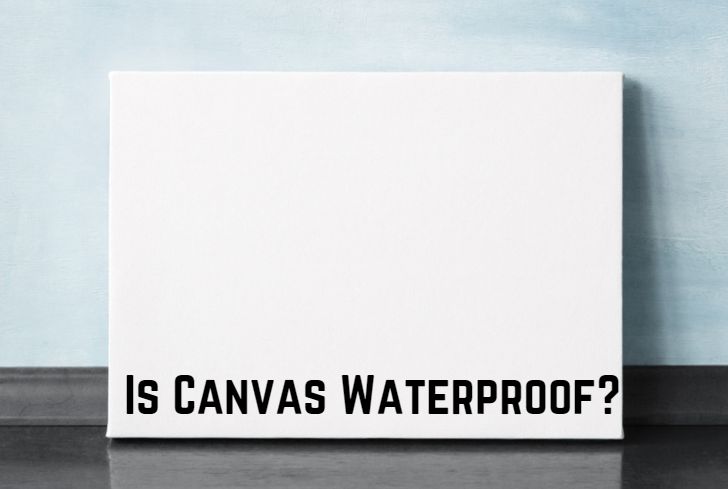Is Canvas Waterproof? (Not Completely)

Canvas is a durable plain-woven fabric that is used for making a variety of things, such as sails, tents, and backpacks. It is also widely used by artists as a painting surface, which is typically stretched across a wooden frame.
Have you ever wondered if a canvas is waterproof? In this article, we are going to discuss just that. We will begin by looking at the composition of canvas and its types. Then we will discuss their resistance to water. Finally, we will talk about the uses of canvases.
What is Canvas Made of?
Canvas is typically made of natural fibers such as cotton or linen, although historically, it was made up of hemp. It can also be composed of synthetic materials, such as polyester or nylon. All canvas is fabric is plain weave.
The word “canvas” derives from the 13th-century Anglo-French word canevaz, which itself leads to the Greek word κάνναβις (cannabis)—“made of hemp”. So, historically, hemp was used to make canvases.
Canvases made up of cotton are also quite common. Cotton fibers are basically spun into a thread and then woven together to form a tight & durable fabric. These cotton fibers are also quite long and strong, which provides additional strength.
Once the fabric is woven, it is often treated with a layer of gesso (a primer made from chalk & glue). This creates a smooth surface, making the canvas ideal for painting. Canvases are also made up of linen, which provides greater strength & finer texture; they are also more expensive.
Besides all these natural fibers (hemp, cotton, and linen), canvases can also be made using synthetic materials, such as polyester and nylon. They are much stronger than natural fibers and are therefore used for heavy-duty and industrial applications.
Finally, all canvas fabric is plain weave, unlike other heavy cotton fabrics like denim, which are twill weave. Plain weave means that warp and weft yarns interlace over and under each other, forming a simple crisscross pattern. This results in a strong and durable fabric.
Is Canvas Waterproof?
Most canvases are made up of natural fibers (hemp, cotton, linen) and are water-resistant. These can withstand some exposure to water but are not completely waterproof. However, with the appropriate coating, we can make canvases waterproof.
First, let us first understand the difference between two commonly confused terms: waterproof and water resistant.
Waterproof means that the material is completely impervious to water. It can be fully submerged without getting damaged. For example, a waterproof raincoat may keep you dry even in heavy rain.
Water-resistant, on the other hand, means that the material can withstand some degree of exposure to water, but it is not completely impervious to it. For example, a water-resistant watch might resist some gentle splashing, but it will get damaged when fully submerged in water.
Most canvases are made up of natural fibers such as hemp, cotton, and linen. They use thick and long fibers that are tightly woven, creating a durable fabric. They are water-resistant and can provide some level of resistance against water.
Therefore, it is common to apply an additional layer of polyvinyl chloride (PVC) on the outer surface of the fabric. This makes it much more resistant to water. For painting purposes, gesso is applied on the canvas, which is then stretched on a wooden frame.
Is Duck Canvas Waterproof?
Duck canvas is a strong & durable fabric, but it is not inherently waterproof. The tight weave of the fabric and its sturdy construction provide some level of water resistance. But in order to make duck canvas completely waterproof, we need additional coating.
Duck canvas is a heavy, woven cotton fabric. What distinguishes it from plain woven fabric is that it is much more tightly woven: it uses two yarns together in the warp and a single yarn in the weft.
Cotton duck canvases have a wide range of applications, such as sneakers, tents, painting surfaces, etc. In fact, cotton duck canvases led to the creation of duct tape in the late 19th century.
The tight weave of duck canvases provides some resistance to water, but in order to make it completely waterproof, we need additional coating. A wax or silicone coating can be applied to the fabric, and it will prevent it from soaking.
This coating is especially done for industrial and outdoor applications, such as for making tents, awnings, and heavy-duty bags.
However, it must be noted that, even after additional coating, canvases may not be absolutely waterproof. Prolonged exposure to heavy rain or immersion in water can still damage it. Plus, over time, the coating of the canvas can also get weak, providing less protection.
Is Waxed Canvas Waterproof?
Yes, waxed canvas is quite waterproof. Cotton canvas can withstand some level of exposure to water, and treating it with wax improves the resistance further. However, even after waxing, the canvas may not withstand complete immersion.
Waxed cotton is basically a cotton canvas impregnated with a paraffin or natural beeswax-based wax, which is woven into or applied to the cloth. The product developed in the sailing industry and was widely popular during the mid-20th century for waterproofing purposes.
The wax coating of the fabric helps to repel water and prevent it from soaking. The coating also makes the surface look shiny and waxy, which develops a unique patina over time. This gives the fabric a unique “classic” look, often associated with traditional workwear.
Waxed canvas is widely used for making garments (jackets, hats, and bags) and house decor items (tablecloths & cushions). It is also used to make outdoor gear, such as tents and backpacks, where its waterproof qualities come in handy.
However, even waxed canvas can not survive excessive exposure to water or immersion. Waxed canvas has largely been replaced by modern materials because it is not very breathable and is also bulkier than synthetic waterproof materials.
How to Waterproof a Canvas?
If you have a canvas with no coating or an old canvas whose coating is damaged, then you need to apply coating on it. This will make it much more water-resistant, ensuring that no moisture gets in the fabric and causes mold growth.
There are mainly two ways of waterproofing your canvas: waxing and spraying method. The former is cheaper but requires more time; the latter is expensive but is quick & easy.
Follow these steps for the waxing method:
- If the canvas is washable, first clean it thoroughly and let it dry. If it is not washable, then use a lint roller to remove the surface dirt. You can also use a vacuum cleaner.
- Melt a bar of beeswax in a double boiler. Or you use a pan to melt it on low heat.
- Use a clean brush and brush the melted wax onto the canvas. Work in small sections and make sure you cover the entire surface.
- Use a heat gun (or a hair dryer) to heat the wax. This will help it penetrate the fibers of the canvas.
- Use a clean cloth to buff the surface of the canvas and remove any excess wax.
- Let the canvas dry completely.
You can also check out this video to learn how to waterproof a canvas using the waxing method.
If you wish to use the spray method, then follow these steps:
- Begin by cleaning the canvas fabric. Use a brush and mild soap to wash it thoroughly, and then let it dry.
- Get a high-quality waterproofing spray designed for canvas materials; these usually contain fluoropolymer.
- Make sure that you are in a well-ventilated area because waterproofing sprays can release toxic fumes. You can also cover the floor and surrounding furniture to prevent staining them with the solution.
- Apply the waterproofing spray on the canvas. Make sure that it is applied evenly. Let the canvas dry.
In order to test the waterproofing method, you can hang your canvas on a wire and splash a bucket of water over it. The water should roll off the surface, instead of getting absorbed.
If this happens, then you have successfully waterproofed your canvas. If not, then you need to dry the canvas completely, and then try a waterproofing method from the start.
Uses of Waterproof Canvas
Waterproof canvas has many applications, especially in outdoor apparel and equipment, where water resistance is crucial. Some popular uses include:
- Outdoor Garments: Waterproof canvas is often used in jackets, hats, pants, etc. They protect the wearer from rain, snow, and other harsh weather conditions.
- Tents and Tarps: They are used to make tents, tarps, and other outdoor shelters.
- Bags and Backpacks: Waterproof canvas is commonly used in bags, backpacks, and other carrying equipment. Waxed canvas especially comes with a classy, timeless look.
- Boat Covers: It is ideal for boat covers, protecting the boat from rain and moisture. It also shields against UV damage from the sun.
- Upholstery: Waterproof canvas is also used in outdoor furniture upholstery to protect it from weather elements.
Conclusion
In this article, we have discussed whether canvases are waterproof or not. The strong weaving and sturdy structure of canvases provide them with some level of water resistance. However, they need an additional layer of coating to become waterproof. We looked at the composition of canvases and their uses. We also discussed how to waterproof them.






